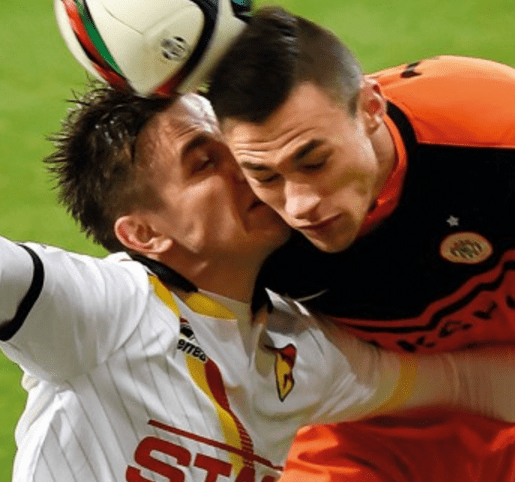A Clash of heads – article by specialist sports law barrister, Craig Moore

Concussion in Sport
Where are we Heading?

About the author: Craig Moore is nationally recognised for his expertise in Sport Law and is recommended in the Chambers & Partners Guide to the Bar. He is a Specialist Member of the Football Association’s Judicial Panel and handles cases for governing bodies, clubs and individual sportspeople in cycling, rugby union and football. A version of this full article was published in the Claims Magazine (December 2015, Issue 22).
Intro: For many years there has been a passive acceptance within the sporting world of concussive injuries and their consequences. However, with the new FA guidelines providing strict rules on the management of concussion, it now means that head injuries are a firm fixture in the minds of all those involved in sport. Parklane Plowden barrister, Craig Moore, explores the change in culture towards concussion injuries, discusses the key features of the guidelines, as well as the difficulties surrounding diagnosis and the long term impact that such an injury can have on players.
Bert Trautmans heroics during the 1956 FA Cup Final have acquired legendary, almost mythical, status in football folklore. Despite sustaining concussion and a broken neck during a collision with an opposing player, Trautmann continued to play as goalkeeper for the final 15 minutes of the game and made further saves which helped Manchester City to win the Cup. The fact that he had dislocated five vertebrae and risked further catastrophic, potentially fatal, injury by continuing to play was not identified until several days later. The fact that Trautmann was a German living and working in austere post-war Britain has added to the mystique surrounding the story.
Bravery and selfless commitment to a cause are human qualities that we understandably admire. Our admiration is almost always blind to nationality or ethnicity. It has, though, contributed significantly to a failure to identify sooner the dangers of head injuries in sport. Together with an ignorance of the significant risks associated with brain trauma, it created an inertia within certain sports, including football, which persisted for over 50 years following the Trautmann Cup Final. For most of that period, a culture of passive acceptance of concussive injuries and their consequences existed amongst players, managers, coaches, medical staff, owners and governing bodies alike.
As recently as November 2013, the Tottenham Hotspur goalkeeper, Hugo Lloris, was allowed to continue playing after sustaining a head injury following a collision with an opposing striker. Lloris appeared to lose consciousness – although the Club subsequently disputed this. He was attended by the club doctor and club physiotherapist on the pitch. A stretcher was brought on and Tottenhan’s reserve goalkeeper – an option unheard of in Trautmann’s day – was ready to replace him. As Lloris was being led to the touchline he resisted and said that he wanted to carry on. Tottenham’s Coach at the time, André Villas Boas, directed Lloris to return to his goal and to continue. The Everton striker with whom he had collided had to be replaced as a result of the injury to his knee which he sustained when it made contact with the head of Lloris.
Just as Trautmann was over half a century earlier, Lloris was lauded as a hero by commentators and supporters alike. Unlike Trautmann, though, controversy soon ensued over the decision to allow Lloris to continue to play, demonstrating at least an increased awareness of the risks associated with concussion, if not its practical implementation. Although Tottenham claimed that tests carried out after the match showed that he had been fit to continue playing, FIFA’s Chief Medical Officer was insistent that Lloris should have been withdrawn. Robust statements, critical of the decision to allow a player to continue playing after losing consciousness were also issued by the head injury charity, Headway, and by both the Professional Footballers Association and FifPro (the domestic and global unions respectively for professional footballers).
New guidelines and rules were introduced by The FA for the 2014/15 season for the management of concussion and head injuries in football. They followed a review by its Medical Committee which was undertaken in 2013. The guidelines set out the procedures and processes that should follow a suspected head injury and how players should be re-introduced to competitive football over time via a return to play™ rules. The key features are these:
All players must now undergo pre-season baseline cognitive training to detect any risk that may exist through previous injury. Any player who has suffered two or more episodes of head injury must go through mandatory detailed psychometric testing.
If there is a confirmed or suspected period of loss of consciousness, the player must be removed from the field of play and not be allowed to return. Where no loss of consciousness is apparent, an on-field or touchline assessment will take place.
Where there has been a head injury, but no loss of consciousness, an on-field or touchline assessment will take place using the Pocket Concussion Recognition Tool which should be a standard item of any pitch-side medical kit. The decision whether the player is removed from the field should be made by the attending doctor.
If the player has been removed from the field of play because of a suspected or confirmed concussion, they should be monitored until deemed fit and able to leave the venue. If in doubt, further opinion from local hospital services should be sought via the accident and emergency department.
If allowed home, the player should not be allowed to drive, and should not be left alone, but with a responsible adult who is instructed that should there be any deterioration in the player’s condition, urgent medical attention must be sought.
If there is no medical attendant present, and if there is any suspicion of concussion, the player must be removed from the field of play and not allowed to return. In such a case, medical advice should be sought from the accident and emergency department of a hospital.
Concussion is a brain injury which should be followed by a period of both physical and mental rest for at least 24 hours after the injury.
Neuropsychological testing should be carried out every 48 hours after the injury until return to play, and show a gradual return to baseline. Clinical assessment should be made daily, with a minimum return to play period of six days. It often takes longer.
The player should be examined and receive the all-clear from the club medical officer before returning to play.
Each of the return to play steps must be passed before progressing to the next. Any recurrence or persistence of concussion symptoms such as headache, feeling in a fog, disturbed or blurred vision, sleep disturbance or unusual emotional behaviour are signs that the player should return to the previous step.
FA Premier League Rules were also amended for the 2014/15 season to establish that the decision of the team doctor is final when assessing whether a player who has sustained a head injury is, or is not, fit to continue playing or training. The PL rules also require the presence of a member of a club’s medical team to look after players with a head injury that leave the field of play.
Those developments drew on the recommendations that were made at the 4th International Conference on Concussion in Sport in 2012, published in 2013.[1] A panel of neurological experts – the so-called Zurich Group – defined concussion as a complex pathophysiological process affecting the brain, induced by biomechanical forces. A less clinically-based definition that a lay-person would understand more readily was provided by World Rugby, the governing body for international rugby:
A traumatic brain injury resulting in a disturbance of brain function … common symptoms being headache, dizziness, memory disturbance or balance problems.
The chronic and longterm effects of concussion are still not fully understood. Repeated insults (like heading a football) is believed to be a major risk factor, and an early return to play has been implicated in poorer outcomes.
The first and foremost difficulty is how to diagnose a concussive injury. Indeed, criticism has been made of the definition of concussion as a brain injury within the Zurich Guidelines. Its detractors are of the view that concussive syndrome does not have to involve the brain.[2] This, they argue, has led to a lack of diagnostic specificity, management strategies that are not evidence-based, and rehabilitation goals that are not realistically attainable.
The difficulty surrounding diagnosis of a concussive head injury is underlined by the fact that symptoms can vary, are mostly non-specific, and may evolve over the course of a number of days, perhaps longer. As yet, there is no single objective test that is capable of being carried out and a diagnosis relies heavily upon a clinical assessment. The Zurich Group recommended the use of the Standard Concussion Assessment Tool, a checklist of tests to be used by a medical practitioner where concussion is suspected. Ultimately, though, the checklist is just that: a checklist, and a diagnosis requires a clinical judgment to be made.
There are also problematic ethical issues bound up in all of this. Firstly, there is a patient’s right to choose or refuse treatment. When a player is removed from the field of play, often against his will, the effects of a suspected concussion are unlikely to be fully known. The giving of informed consent to treatment is another difficulty in the context of someone who has suffered concussion. Thirdly, and from the doctor™s standpoint, there is a potential conflict of interest between serving the best interests of the injured player, but also the club paying his or her wages. The latter issue can be partly addressed by the presence of an independent doctor who has the authority to remove any player who is suspected of having suffered concussion. But if an independent opinion is absent, as it so often is, a conflict will exist, even if it is only the appearance of conflict.
The delayed reaction in this country to a recognition of the risks of head trauma in sport can be contrasted with the position in the US where recurrent insults have for some time been associated with a progressive deterioration in brain function. Perhaps, not surprisingly, litigation (or the threat of it) has acted as a catalyst for a greater understanding of the risks and, crucially, change. A lawsuit brought in 2011 involving more than 4,500 former NFL players alleged that the governing body of the sport knew, or ought to have known, that players who sustain repetitive head injuries are at risk of suffering a constellation of neurological and psychological conditions, including:
- Early onset of Alzheimer’s Disease;
- Dementia;
- Depression;
- Deficits in cognitive functioning;
- Reduced processing speed, attention and reasoning;
- Loss of memory;
- Sleeplessness;
- Mood swings;
- Personality changes; and
- Chronic Traumatic Encephalopathy (CTE).
CTE, a progressive degenerative disease of the brain found commonly in boxers, is arguably the most damaging longterm effect of brain injury and was diagnosed in a number of cases. Symptoms of CTE include memory loss and mood swings.
The likely traumatic effect of repeated, fast-moving and violent helmet-to-helmet insults is not difficult to imagine. A number of former NFL players had committed suicide, including Ray Easterling, the former Atlanta Falcons player in whose name the lawsuit was filed. The claims against the NFL were subject to a lengthy mediation process which culminated in a $765 million (£490 million) settlement, but which Easterling and other former players did not live to see.
This week, the United States Soccer Federation unveiled a series of safety initiatives directed at head injuries in the sport at youth level. The principal measure is a policy that sets strict limits on youth players heading the ball. It will prohibit players aged 10 and below from heading the ball at all, and reduce the number of headers that those aged between 11 and 13 will be able to make during practice. The new guidelines resolve a proposed class-action lawsuit filed against the governing Federation, and others (including FIFA), in 2014. The claims alleged negligence in treating an monitoring head injuries, but no financial compensation was sought, only rule changes.
In this country, Jeff Astle, the former West Bromwich Albion and England Footballer developed degenerative brain disease linked to his repeated heading of a football. During his playing days in the 1960’s, footballs were much heavier when wet than modern footballs are. At the time of his untimely death in 2002, aged just 59, Astle did not know that he had ever been a footballer, let alone remember the winning goal that he had scored in the 1968 FA Cup Final. Tellingly, an examination of his brain tissue identified CTE, not Alzheimer’s Disease, as the cause of his condition. Around the time of Astle’s death, The FA and The PFA commissioned a study to analyse the effects of heading a football over a 10-year period, but no conclusions were reached because all of the young players who were selected for the sample group failed to make the professional grade and dropped out of the game shortly afterwards. There is currently no reliable evidence to show that modern footballs, dry or wet, are any safer to head repeatedly than their predecessors.
The proposed changes that have just been announced by US Soccer also include amendments to substitution rules to improve protection for players who suffer suspected concussive injuries. Current international rules allow for three substitutions per game during senior level games. There is no provision for temporary substitutions to enable a player with a suspected head injury to be properly examined and, if judged by a doctor to be fit to do so, to then return to the game in place of the temporary substitute. In the absence of an independent doctor, temporary substitutions for a suspected head injury would reduce the pressure on managers and medical staff when making a decision at a critical stage of a game and which may affect its outcome. If a player is judged to be fit enough to return to the field of play, an irreversible decision to substitute him will not have been made. Alternatively, if he is not fit to continue, a permanent substitution can take place.
There is a risk of temporary substitutions being abused, enabling a short-term strategic switch to be made. A fitter player, in the same or a different position, could come on for a short period of time during a critical phase of a match. Such occurrences, though, would hopefully be rare. Although a player might feign injury of his own initiative, for a staged temporary substitution to work effectively at least two people would have to be involved in the deception, conceivably more. The risk of such a sham arrangement being exposed and the likely severe disciplinary consequences that would follow are likely to deter all but the most brazen and reckless from contemplating it.
The greater risk, it is suggested, is one that has already been identified, namely that of players who suffer concussion not wanting to leave the field of play, and presenting themselves in a way that will give them the best chance of remaining on the pitch. Both Codes of Rugby have embraced the Zurich Guidelines. During the recent Rugby Union World Cup, players suspected of concussion were temporarily withdrawn to undergo cognitive, balance and memory testing. By comment consent, Dan Biggar was the outstanding Welsh player in the competition. His clear reluctance to be withdrawn during the closing stages of Wales quarter-final match against South Africa, following a blow to the head, demonstrates that even temporary substitutions will not always be consensual.
At elite level, where an independent medical practitioner is in attendance, his or her clinical judgment should prevail. Most sport, however, does not have that luxury, especially games played at amateur level where there will invariably be no qualified medical practitioner present. The default position set out in The FA guidelines should apply in those circumstances: even if there is a suspicion of concussion, supervised attendance at an accident and emergency department is required. If nothing else, the assimilation of the Zurich Guidelines into the Rules and Regulations of major sports governing bodies means that a standard has been set against which any alleged failure to comply is capable of being measured. The test will be whether that standard will be put into practice, or whether it will take litigation arising out of a concussive injury to focus minds.
As far as scientific developments are concerned, it is anticipated that an objective diagnostic tool for assessing head injuries will become available in the foreseeable future. A research study currently being conducted at Sheffield Hallam University is seeking to identify the changes that occur to the structure of the eye during a concussive episode. Retinal scanners, which are already in routine use, provide information about nerve fibres, blood vessels, and the eye’s ability to discern colour. It is anticipated that a portable retina scanner would be used to examine an injured player’s eye following a suspected concussion. The data collected would then be compared with healthy readings, facilitating an independent and speedy clinical assessment by the touchline. If and when such a tool becomes available, the initial difficulties in diagnosis referred to above will hopefully be reduced, if not removed altogether. The efficacy of strategies for managing head injuries, and whether rehabilitation goals are attainable, are likely to remain controversial subjects.
There must also be a significant cultural shift in our perception of players who insist on playing after sustaining a head injury. Heroism is an epithet that is entirely apt in other fields of endeavour, but with respect to the late, great Bill Shankly he was wrong: football is not a matter of life and death, let alone more important than that. Instead, we should applaud players like Trautmann and Lloriss for leaving the pitch, not for staying on.
[1] Consensus Statement on Concussion in Sport, 4th International Conference on Concussion in Sport held in Zurich, November 2012: BR J Sports Med 2013; 47:5 250-258
[2] ‘Time to Re-think the Zurich Guidelines?’: A Critique on the Consensus Statement on Concussion in Sport: The 4th International Conference on Concussion in Sport, Held in Zurich, November 2012; Clinical Journal of Sport Medicine, March 2014, Volume 24, Issue 2, pp93-95.
This note has been prepared by Craig Moore.
Chambers & Partners 2016 (Sports Law) Ranked Nationally
Handles cases for governing bodies, clubs and individual sportspeople in cycling, rugby union and football. He is regularly engaged on both contentious and non-contentious matters and has recently advised sports clients on insurance and personal injury claims.
Chambers and Partners 2015
Acts for sports governing bodies and individuals on commercial matters, including sponsorship and insurance. He works with clients from a broad range of sports, including cycling, football, rugby and extreme sports.
Chambers and Partners 2014
He has advised and acted for sports organisations on commercial disputes. He has also acted for individual sportsmen and women in disciplinary and integrity cases in swimming, rowing and football.










